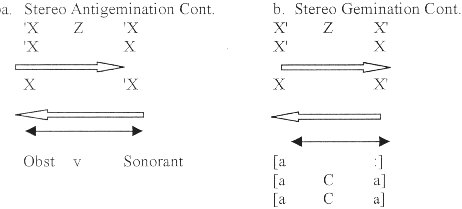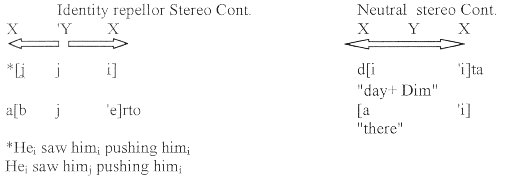
5.4.5 Stabilisation: binding
The construction discussed here uses Vocoidal assimilatory and Consonantal dissimilatory binding. I will suggest that this binding has a Predicate Argument combinatorial property.
| (29) | |
 |
The Predicate expresses assimilation (X') or dissimilation ('X) with the value of the Argument (X).1 There are two non-simultaneous integrative possibilities: Dextro and Levo.
| (30) | |
 |
In Spanish the Point of articulation of a Glide enters in a Dissimilatory Binding with the Vowel, in both Dextro *[ji] and Levo *[ij] integrations (30d). This accounts for reduction of two presumptive identical Vocoids GV/VG onto the Vowel. 2 Other cases of dissimilation are High-Mid dissimilation in root verbs (30b) (García-Bellido 1986) or Liquid dissimilation in a Base+aLi (30c). The svarabhakti Vocoid enters in a Dextro assimilatory binding (30a) with the following Vocoid, (9i), or a Levo assimilatory binding with the preceding Vocoid, (9iv). The Rhotic in its non-peripheral stabilisation (9i,ii,iii) serves as a connector of the Vocoidal assimilatory binding (31b) and equally the svarabhakti serves as a connector of the Consonantal dissimilatoy binding (31a). Since the assimilatory binding of Vocoids is discontinuous in the svarabhakti construction, one might think that it could be a replication process (7i,ii) which has been interrupted in the sequence by the Rhotic. However the fact that a Glide, which arises from a diphthongisation process (19), may be the source of the binding (7iii), suggests that the savarabhakti is not a replication of a Vowel but an independent element binding with the first Vocoid after the intervocoidal Consonant.
The Place of Articulation of the svarabhakti (x') does not bind with the (x) of the Category Vowel, since the Argument of the binding is selected in a Vocoid state, where categories as G, V are not differentiated. This selection is therefore a high order operation whose result is a "short distance" binding [vCG]. If the selection would have been at a lower differentiated level selecting a V, then binding would have resulted in a "long distance" binding [v CGV]. The latter case occurs in the Spanish Dextro dissimilatory binding in (30b) [VCGV] p[[idje]ndo "asking" where V selects V. Following Rizzi (1990) and his Relativised Minimality notion for Syntactic constrained movement and following Goldsmith (1976) and his non-crossing autosegmental constraint for Phonological spreading, binding of a svarabhakti across a Glide vocoid to select the V is impossible here, since their minimal binding is "short distance", however the same constraints would be violated with the Spanish dissimilatory process *[VCGV]. The svarabhakti functions as a Z in (31a), an antigemination connector which imposes dissimilation on the relation between both Consonantal Arguments. They cannot be both identical as Sonorants (cf. 8iib).
| (31) | |
 |
In (31), Z evens up the relation between Arguments either as different or as identical.
(31b) is a double assimilatory process, referred here as gemination, whereby Z evens up the relation between both
Arguments of Z until they are identical. The bond between the pair of Arguments in cases where Z is not linguistically expressed
with an element may be strong (==) and the order irrelevant, mixing in one articulatory unit. In Spanish, strong gemination is not
a combinatorial process used to associate it with meaning.3 The Identity repellor Stereo connector
is a Y which cannot be identical to any of its Arguments. This is shown in the Spanish prevocalic Glide when it stabilises as
nonperipheric (9v, 32). The Prevocalic Glide cannot be identical in Voiced-Palatality to its following or its preceding Argument in
Spanish and there is a Voiced-Palatal Consonant which cannot be identical to its following or preceding Vocoid (García-Bellido 2000).
This Identity repellor Y connector does not impose a relation of identity or difference between its arguments since it allows both
arguments to be identical in Place of articulation: mon[ wi] "Montjuit" [gju]. This effect can be seen in word
sequencing in (32).
wi] "Montjuit" [gju]. This effect can be seen in word
sequencing in (32).
| (32) | |
 |
The plasticity of Binding domains shows that it can operate intra-combinatorially or extra-combinatorially. For instance, the dissimilatory binding of P3 when it is expressed as a G occurs in the combinatorial domain of the G with V. This can be seen in the P3 of (7v). The assimilatory binding of P3 when it is expressed as a svarabhakti occurs outside the combinatorial domain of the svarabhakti with its two Consonants. This can be seen in the P3 of (7i,ii,iii).
1 The Argument here is equivalent to the Antecedent in syntactic theory (Chomsky 1995).
2 This is the process called sinalefa (Navarro Tomás 1968:§137).
3 Pairs such as apreender a[peRe e]nder "to aprehend" vs aprender
a[peRe]nder "to learn" are examples of two Vowels connected with a neutral stereo connector (32) vs. two Vocoids connected
with a stereo gemination Connector where Z is a C (31b) respectively.
Volumen 22 (2005) ISSN: 1139-8736 |